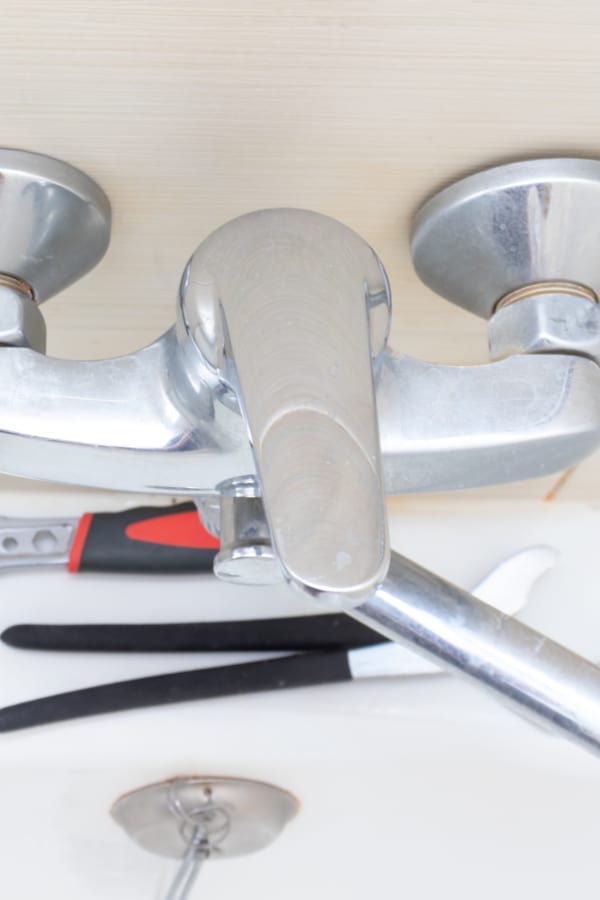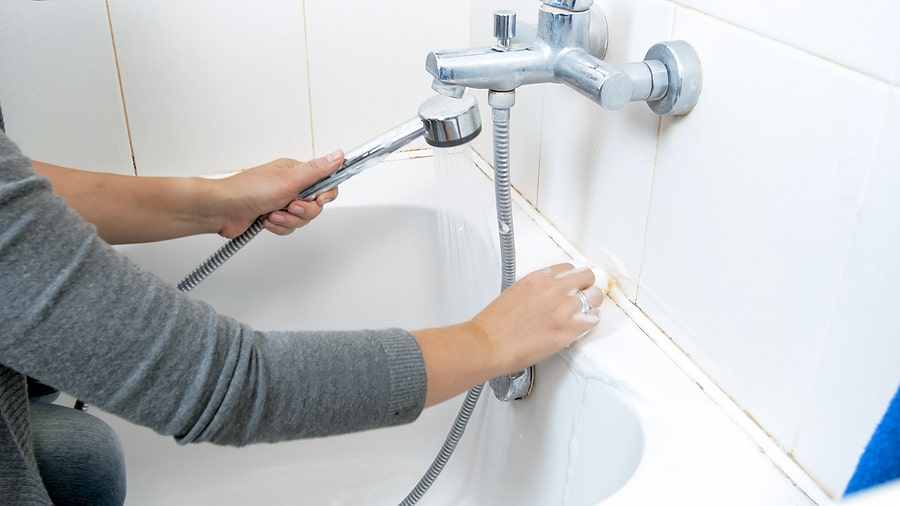How to fix A leaky bathtub faucet in easy steps. Did you just notice that constant dripping in your bathroom? Or has your bathtub faucet been leaking for ages, and you’ve simply just ignored it?
See, I know how upsetting and subtly noisy those per second drips can be. But much more, gallons of water are going down the drain, which invariably equals an increase in your water bill.
Should we also delve into the few health problems that a seemingly harmless leaky bathtub might cause? (that’s a story for another day). Nobody wants all of these.
In this article, you will learn the common causes of a leaky bathtub faucet (just so you know in case you didn’t) and, more importantly, the ways to fix a leaky bathtub faucet.
What Are The Common Causes Of A Leaky Bathtub Faucet?
I get to wonder what causes the bathtub faucet to discover a fault out-of-the-blues. I guess we both share that wonder.
Some of those reasons are not far-fetched. Here are some of the common factors that result in a leaky bathtub faucet:
High water pressure: A faulty bathtub faucet happens when the faucet is turned on, and water rushes in with force and at an unusually high rate.
This, in turn, can force the water out of areas around the faucets because the quantity and the pressure of water are too much for the capacity of the faucet.
In the end, because another part has been made for water to escape, water droplets would continue to flow in that direction until it is fixed.
An Improperly Installed Washer: Bathtub leakages can be a result of an improperly installed washer.
A washer improperly fixed can be attributed to the washer not being the perfect size for the faucet. Washers are those thick, elastic bands that function as seals.
When they are not well placed or are wrong-sized, water would surely escape even when the faucet is supposedly closed up.
A Worn-out Washer: A worn-out washer is one of the most common causes of a leaky bathtub faucet, and this also applies to other faucets in the home.
When you notice water seeping from the spout, it’s a worn-out washer.
Here’s what leads to a worn-out washer: Apparently, the role of the washer or seal washer is to stop the flow of water.
So, when we shut the faucet, the seal washers do the job of holding the water off till the faucet is turned on. The washer holding up the water over time can lead to its hardening and eventually wearing out.
In some cases, the friction between the washer and the valve seat can cause a tear. This eventually makes the washer unable to hold on to its task.
Problem With The O-ring: When the bathtub faucet drips from the handle, something is up with the O-ring. The O-ring is a disc around the handle of the faucet.
It functions as a screw that helps the faucet handle to stay locked and opened when any of such functions is used. An O-ring can become loose and cause water to flow through the handle.
Corrosion Of The Valve Seat: When the valve seat, the connector between the faucet and the spout, is corroded, water finds its way out of the faucet.
This is because the faucet would become faulty. How does the valve seat experience corrosion?
It is pertinent to state that a corroded valve seat is not exclusive. Almost every home experiences it. That is why your plumber recommended a monthly check and clean-up.
A corroded valve seat results from a mineral buildup or accumulation of water sediments in the valve seat.
To avoid a faulty faucet, as the accumulation of water sediments is almost unavoidable, ensure that the valve seat is cleaned up from time to time.
.
Broken Parts: Another cause of a leaky bathtub faucet can be attributed to a broken inner part. When a plumber disassembles the faucet, in some cases, he/she discovers that the plastic stem might be broken or damaged at a particular side.
That is why it is always advisable to purchase a brass stem in place of a plastic stem because they do not tend to get damaged over a long time.
Although the brass stem has its challenges, which is mainly from a worn-out or squeezed washer; however, to avoid a broken part, a brass stem is more preferable.
How To Fix A Leaky Bathtub Faucet
There’s no one-fit-size rule that applies to how to fix a leaky bathtub faucet should be fixed because different factors lead to the situation.
Some of the solutions to repairing a faulty bathtub faucet can be done by you, while others need the intervention of a pro plumber.
Below, I’ve reviewed some of the ways on how to fix a leaky bathtub faucet:
Worn Out Faucet:
- Put off the water supply or water meter running into the house.
- Open up the handles button from the faucet using a flat blade screwdriver
- Use the screwdriver to remove the screws connecting the handles from the faucets and completely remove them.
- Remove the stems off the faucet through a stem socket or lubricant.
- Place the stem socket on each one of the screws and turn them anti-clockwise to pull them out. In cases whereby the screws are almost impossible to come off, that’s where the lubricants come in
- Apply the lubricants on the stems and let them settle for about 20 minutes. After that, place the socket on the stem and turn anti-clockwise.
- Use a screwdriver to uncork the seat washers from the screws. After removing the old seat washers, apply sealant on the thread of the seat washers, then place in a new set of seat washers.
- Turn the seat washers in a clockwise direction to lock them in place.
- Place the faucet handles back in and secure with the handle screws, then turn on the water supply.
.
Corrosion Of The Valve Seat:
- Open up the faucet and disassemble the inner parts
- In the stem is brass equipment.
- If you do not plan to replace the valve seat, you can wash it. This is done by pouring white vinegar onto the valve seat.
- Let the white vinegar settle and spread around the valve seat. The next step is to use a soft scrub then to wash the valve seat, especially parts where there has been concentrated mineral buildup.
- Rinse the valve seat with water.

On the other hand, you can also replace the valve seat.
- Remove the valve seat from the stem with the aid of a seat wrench.
- Insert the stem wrench and turn anti-clockwise to get the valve seat out.
- Place the new valve seat into the stem and use the stem wrench to turn the new valve seat clockwise till it is firmly in.
- Be very careful of the force at which the seat wrench turns the new valve seat. This is to avoid excessive scratches on the brass.
Fixing A Single Hand Bathtub Faucet
- You would need tools like wrench, pliers, needle nose pliers, screwdrivers, and a cleaner.
- The next step is to turn off the water supply that flows to your home
- Press the faucet button, and with the aid of the screwdriver, unhook it.
- Use the screwdriver to lose the handle screw to access the inner part and remove the handle.
- Then turn the cam nut anticlockwise to remove. Do the same for the plastic nut.
- Just inside the stem is a ball. Take it off and use the needle-nose plier to remove the spring where the ball laid.
- Use the soft towel to clean the inside of the faucet before placing the rubber and spring back into their holes.
- Place the ball back into its place, cover up with the plastic closure, and then the cam nut.
- With the aid of a screwdriver, screw the faucet handle back in and its button.
- Turn on the water supply, and your faucet is good as new.
- You can also completely change your faucet and install a brass faucet instead.
Fixing A Double/Triple Hand Bathtub Faucet
- Get the following tools: a flat head screwdriver, a Philip screwdriver, a wrench, and a seat removal tool.
- Check each of the handles to determine precisely where the leak is coming from.
- Also, discover which temperature of the water is dripping, either the cold or hot water. You can find out with the aid of an access panel or by making a guess.
- The next thing to always do is turn off the water meter or the water supply running into the house.
- After doing that, you will need to take off the index cap of the handle. Here is where the flat head screwdriver comes in handy.
- When the index cap is off, use the screwdriver to lose the handle screw to take it off.
- At this point, it is easy to pull off the spout and the stem. Make use of a wrench to take off the stem if it is a brass stem.
- For the brass stem, examine the washer to determine if it is worn out and needs a replacement. If so, remove the old washer and place a new one in.
- At this point, remove the old faucet seat with a seat removal. Turn it anti-clockwise to unscrew it out, then replace it with a new faucet seat. Turn it in a clockwise direction to lock it in.
- Replace the old plastic or brass stem and screw them in.
- Fix in the spout and the handle. Finally, tighten the handle with its screw and replace the index cap.
- Turn the water supply on and examine if there is any leakage.
.
Conclusion
Fixing up your bathtub faucet immediately when you notice a leak is important.
Also, the best way to get your leaky bathtub faucet fixed is to call on a good and reputable plumber, especially if you are dealing with a shower faucet.
Trying to fix it by yourself, especially when you have no prior experience with it, can lead to you causing more damage than you would realize.
You can even end up touching what isn’t the problem.
Got anyone with a faucet problem? Then give them a helping hand by sharing this article.
Thanks for reading!





